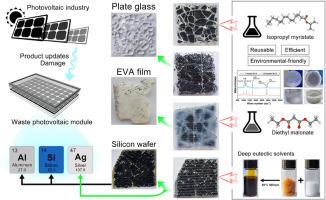Recycling of waste crystalline silicon photovoltaic modules: Efficient decapsulation and silver extraction using environmental-friendly reagents and deep eutectic solvents
IF 6.3
2区 材料科学
Q2 ENERGY & FUELS
引用次数: 0
Abstract
The transformation of the global energy structure has driven the rapid development of the photovoltaic industry, inevitably leading to the generation of upgraded and end-of-life photovoltaic waste. Effective treatment of this waste is crucial for environmental protection and advancing the circular economy. Crystalline silicon photovoltaic modules, which dominate the market, contain high-value recyclable materials such as plate glass and silver. Decapsulation, the critical first step in recycling, enables the separation of layered panel materials. This study employs environmental-friendly isopropyl myristate and diethyl malonate for decapsulation, achieving optimal processing within 60 min. These reagents retained high purity and generated minimal byproducts even after 40 reuse cycles, demonstrating excellent reusability. The characteristic functional group peaks of the ethylene vinyl acetate encapsulant remained unchanged, with only variations in peak intensity. The disruption and reorganization of its cross-linked structure weakened its adhesion to other panel layers. These reagents exhibited limited leaching effects on Ag from solar cells, facilitating subsequent Ag recovery. A stable deep eutectic solvents synthesized from FeCl3·6H2O and urea demonstrated low melting points of approximately −25.98 °C (molar ratio 1:1) and −54.09 °C (molar ratio 1:3). This deep eutectic solvents efficiently enriched Ag from delaminated solar cells, achieving a 93.55 % Ag extraction rate (20 min, 80 °C, 400 rpm). This study combines the wet decapsulation of photovoltaic modules with the Ag extraction of solar cells. The eco-friendly reagents adopted provide new guidance for the recycling of waste photovoltaic modules.

废旧晶硅光伏组件的回收利用:利用环保试剂和深共晶溶剂高效解封装和提银
全球能源结构的转型带动了光伏产业的快速发展,不可避免地导致了升级版和报废光伏废弃物的产生。有效处理这些废物对环境保护和推进循环经济至关重要。占据市场主导地位的晶体硅光伏组件含有高价值的可回收材料,如平板玻璃和银。解封装,在回收的关键的第一步,使分层面板材料的分离。本研究采用环保型肉豆肉酸异丙酯和丙二酸二乙酯进行脱胶囊,在60分钟内达到最佳处理效果。这些试剂在重复使用40次后仍保持高纯度,产生的副产物最少,具有良好的可重复使用性。乙酸乙烯酯包封剂的特征官能团峰保持不变,只是峰强度有所变化。其交联结构的破坏和重组削弱了其与其他面板层的附着力。这些试剂对太阳能电池中银的浸出作用有限,有利于随后的银回收。由FeCl3·6H2O和尿素合成的深共晶溶剂具有较低的熔点,熔点约为- 25.98℃(摩尔比为1:1)和- 54.09℃(摩尔比为1:3)。这种深度共晶溶剂有效地富集了分层太阳能电池中的银,达到了93.55%的银提取率(20分钟,80°C, 400 rpm)。本研究将光伏组件的湿解封装与太阳能电池的银提取相结合。采用的环保试剂为废旧光伏组件的回收利用提供了新的指导。
本文章由计算机程序翻译,如有差异,请以英文原文为准。
求助全文
约1分钟内获得全文
求助全文
来源期刊

Solar Energy Materials and Solar Cells
工程技术-材料科学:综合
CiteScore
12.60
自引率
11.60%
发文量
513
审稿时长
47 days
期刊介绍:
Solar Energy Materials & Solar Cells is intended as a vehicle for the dissemination of research results on materials science and technology related to photovoltaic, photothermal and photoelectrochemical solar energy conversion. Materials science is taken in the broadest possible sense and encompasses physics, chemistry, optics, materials fabrication and analysis for all types of materials.
 求助内容:
求助内容: 应助结果提醒方式:
应助结果提醒方式:


